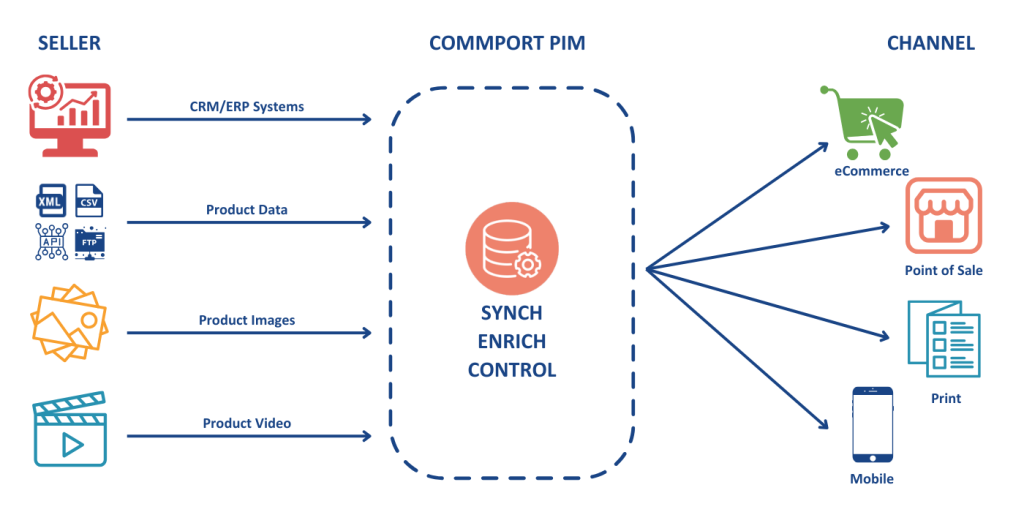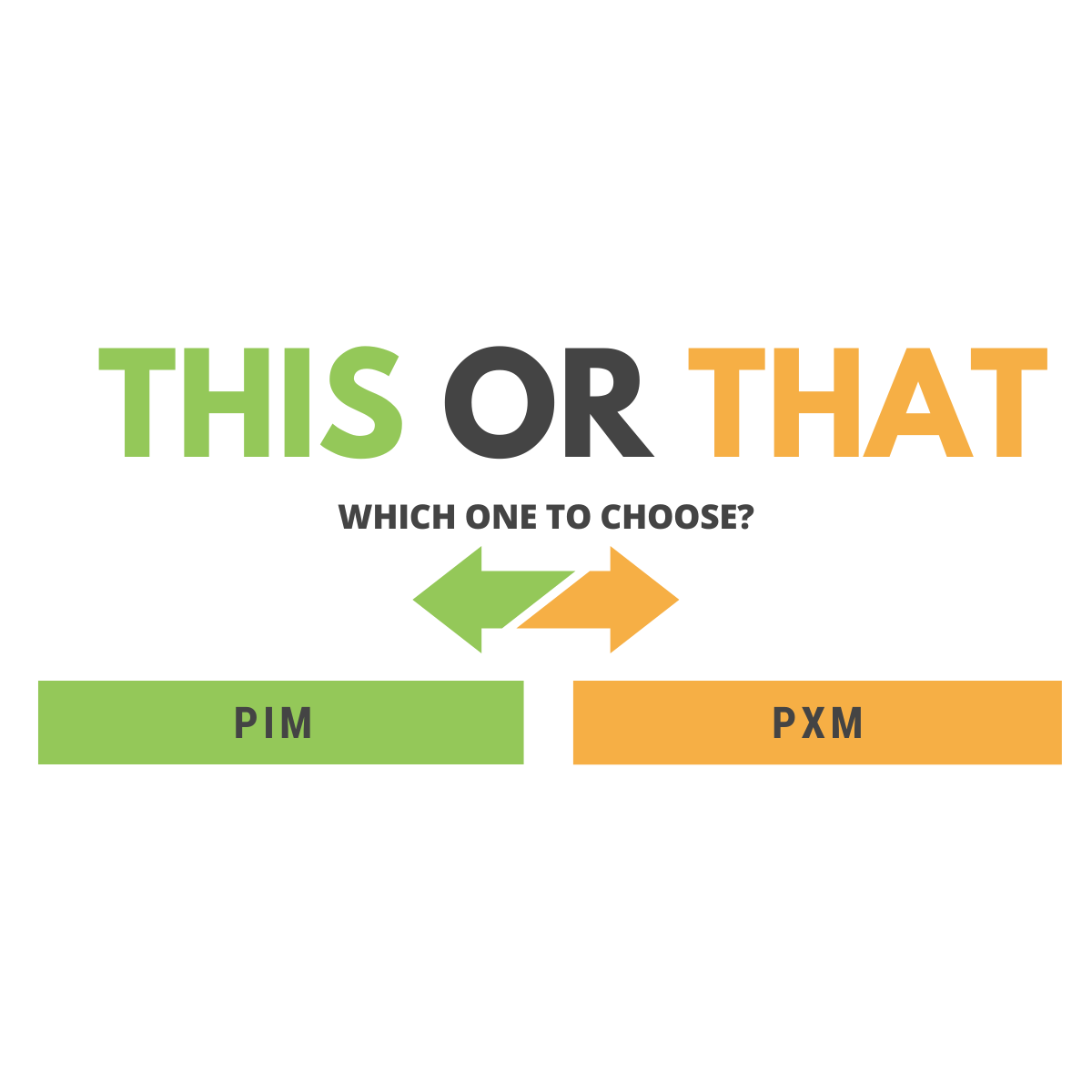Introduction
The debate over PIM vs PXM is ongoing with the rise of omnichannel retailing, companies need robust systems to manage their product data and create engaging customer experiences.
This is where PIM and PXM come into play, each offering unique capabilities to help businesses thrive in the digital age.
While these concepts are related, they serve distinct purposes in the product lifecycle.
Let’s dive deep into the key difference between PIM vs PXM to understand their unique roles and how they complement each other in creating stellar product experiences.
Understanding Product Information Management (PIM)

At its core, PIM is a system designed to centralize, manage, and distribute product information across various channels. This centralized approach to data management ensures consistency and accuracy in product information, which is crucial for businesses operating in multiple markets or through various sales channels.
PIM systems serve as a single source of truth for all product-related data. This includes basic information such as product names, descriptions, and pricing, as well as more complex data like technical specifications, digital assets (images, videos), and even marketing content. By consolidating all this information in one place, PIM solutions enable businesses to maintain data integrity and streamline their product information workflows.
One of the key advantages of PIM is its ability to support multi-channel and omnichannel strategies. In today’s digital landscape, consumers interact with brands through numerous touchpoints – websites, mobile apps, social media platforms, and physical stores. PIM ensures that regardless of the channel, customers receive consistent and up-to-date product information. This consistency is vital for building trust and delivering a seamless customer experience across all platforms.
Moreover, PIM systems often come with robust data governance features. These tools help maintain data quality by enforcing standardization, validating information, and tracking changes over time. Such capabilities are particularly valuable for businesses dealing with large product catalogs or operating in regulated industries where data accuracy is paramount.
Another significant aspect of PIM is its role in facilitating collaboration across different departments within an organization. Marketing teams, product managers, and e-commerce specialists can all work from the same set of product data, ensuring alignment and reducing the risk of errors or inconsistencies in product information.
PIM also plays a crucial role in supporting international expansion. As businesses enter new markets, they often need to adapt their product information to different languages, currencies, and regulatory requirements. A robust PIM system can manage these localization efforts efficiently, ensuring that product information is accurately translated and compliant with local standards.
In essence, PIM serves as the backbone of product data management, providing a solid foundation for businesses to manage their product information effectively. It streamlines processes, improves data quality, and supports multi-channel strategies, all essential in today’s competitive digital marketplace.
Understanding Product Experience Management (PXM)

Product Experience Management, or PXM, represents a more holistic and customer-centric approach to product information. While PIM focuses on managing and organizing product data, PXM takes this a step further by emphasizing how this information is presented and experienced by the customer. It’s about creating a compelling and consistent product story across all touchpoints in the customer journey.
At its heart, PXM is about understanding and optimizing the entire product experience from the customer’s perspective. This includes not just the basic product information, but also how that information is contextualized, personalized, and presented to different customer segments across various channels. PXM strategies aim to create emotional connections between customers and products, going beyond mere facts and figures to tell a compelling product story.
One of the key aspects of PXM is its focus on personalization. In today’s market, customers expect tailored experiences that cater to their specific needs and preferences. PXM systems use data analytics and AI to deliver personalized product recommendations, content, and even pricing strategies based on individual customer behavior and preferences. This level of customization can significantly enhance the customer experience and drive conversions.
Another crucial element of PXM is its emphasis on contextual relevance. This means delivering the right product information to the right customer at the right time and through the right channel. For instance, a customer browsing on a mobile device might need different information compared to someone shopping in-store. PXM systems are designed to adapt product content and presentations based on these contextual factors, ensuring that customers always receive the most relevant and engaging product information.
PXM also plays a vital role in creating consistent brand experiences across all channels. In an omnichannel world, customers expect seamless transitions between different touchpoints. Whether they’re browsing on a website, using a mobile app, or visiting a physical store, the product experience should feel cohesive and aligned with the brand’s overall messaging and values.
Furthermore, PXM strategies often incorporate user-generated content, such as customer reviews and social media mentions, into the product experience. This not only provides social proof but also helps in creating a more authentic and trustworthy product narrative. By integrating these elements, PXM helps in building a more comprehensive and engaging product story that resonates with potential customers.
Another significant aspect of PXM is its focus on continuous improvement. By analyzing customer interactions and feedback, PXM systems can provide valuable insights into how products are perceived and experienced by customers. This data can then be used to refine product descriptions, improve marketing strategies, and even inform product development decisions.
In essence, PXM takes the foundational product data managed by PIM and transforms it into compelling, personalized, and context-aware product experiences. It’s about creating emotional connections, driving engagement, and ultimately, influencing purchasing decisions through superior product storytelling and presentation.
PIM vs PXM - The Key Differences
While PIM and PXM are often mentioned in the same breath, they serve distinct purposes in the product management ecosystem. Understanding these differences is crucial for businesses looking to optimize their product strategies. Let’s delve into the key distinctions between PIM and PXM
Aspect |
PIM |
PXM |
|---|---|---|
|
Focus and Scope |
Primarily focuses on managing and organizing product information. It’s about creating a centralized repository of accurate and consistent product data | Extends beyond data management to encompass the entire product experience. It focuses on how product information is presented, contextualized, and personalized for customers |
| Data vs. Experience | Deals with raw product data – specifications, pricing, inventory levels, etc. It’s about maintaining data accuracy and consistency | Transforms this data into engaging product experiences. It’s about storytelling, creating emotional connections, and presenting products in the most appealing way |
| Internal vs. External Orientation | Largely internally focused, aimed at improving operational efficiency and data management within the organization | Externally focused, aimed at enhancing the customer’s interaction with products across various touchpoints. |
| Functionality | Offers features like data validation, versioning, and syndication to ensure data integrity and distribution | Includes capabilities like personalization engines, content optimization, and analytics to create tailored product experiences |
| User Base | Primarily used by internal teams like product managers, data specialists, and marketing teams | While also used by internal teams, it’s ultimately designed to impact the end consumer’s experience |
| Personalization Level | Generally deals with standardized product information that’s consistent across all channels | Focuses on personalizing product information and presentations based on individual customer preferences and contexts |
| Channel Approach | Ensures consistent product information across all channels | Adapts product presentations and content to suit different channels and customer contexts |
| Metrics and KPIs | Often measured by data accuracy, completeness, and time-to-market for new products. | Evaluated through customer engagement metrics, conversion rates, and overall customer satisfaction |
| Technology Integration | Typically integrates with ERP systems, DAM (Digital Asset Management), and e-commerce platforms | Often integrates with CRM systems, analytics tools, and personalization engines in addition to PIM systems |
| Strategic Impact | Impacts operational efficiency and data quality | Directly influences customer experience, brand perception, and ultimately, sales performance |
The Interplay Between PIM and PXM
While we’ve explored the distinct roles of PIM and PXM, it’s crucial to understand that these systems don’t operate in isolation. The interplay between PIM and PXM is where the real magic happens in creating exceptional product experiences
1. Data Foundation and Experience Layer
PIM serves as the foundational layer, providing clean, accurate, and consistent product data. PXM then takes this data and transforms it into engaging product experiences. This symbiotic relationship ensures that the compelling product stories created by PXM are built on a solid foundation of reliable data.
2. Seamless Data Flow
The integration of PIM and PXM allows for a seamless flow of information. As product data is updated in the PIM system, these changes can automatically reflect in the PXM layer, ensuring that customers always see the most up-to-date and accurate product information, presented most engagingly.
3. Enhanced Personalization
While PIM provides standardized product information, PXM uses this data to create personalized experiences. For instance, PXM can leverage the detailed product attributes stored in PIM to create tailored product recommendations or customized product bundles for different customer segments.
4. Omnichannel Consistency with Contextual Relevance
PIM ensures that core product information remains consistent across all channels. PXM then adapts this information to suit different contexts and channels, maintaining brand consistency while providing channel-specific experiences.
5. Efficient Content Creation
The structured data from PIM serves as a starting point for content creation in PXM. Marketing teams can quickly access accurate product information from PIM and use it to craft compelling product stories and marketing materials through PXM tools.
6. Improved Time-to-Market
The combination of PIM and PXM can significantly reduce time-to-market for new products. PIM streamlines the process of gathering and organizing product information, while PXM accelerates the creation of marketing content and product experiences.
7. Data-Driven Insights
While PIM focuses on managing product data, PXM often includes analytics capabilities. These analytics can provide insights into how customers interact with products, which can then be used to refine the product data stored in PIM, creating a feedback loop for continuous improvement.
8. Scalability and Flexibility
Together, PIM and PXM provide a scalable solution for managing product information and experiences. As businesses grow and expand into new markets or channels, this integrated approach allows for efficient scaling of product management processes.
9. Enhanced Customer Journey Mapping
PIM provides the detailed product information needed to map out potential customer journeys accurately. PXM then uses this information to optimize each touchpoint in these journeys, creating a more cohesive and engaging customer experience.
10. Compliance and Localization
PIM ensures that product information complies with various regulatory standards. PXM can then use this compliant information to create localized experiences for different markets, adapting product presentations to suit local preferences and regulations.
The synergy between PIM and PXM creates a powerful ecosystem for product management and customer experience. While PIM ensures that the underlying product data is accurate, consistent, and well-organized, PXM transforms this data into compelling, personalized product experiences that resonate with customers
Conclusion
Product Information Management (PIM) and Product Experience Management (PXM) are two interconnected pillars that form the foundation of successful digital commerce strategies. While distinct in their focus and functionality, these systems work in tandem to create a powerful ecosystem that drives both operational efficiency and customer engagement.
As we look to the future, the importance of integrating PIM and PXM will only grow. Emerging technologies like AI, AR/VR, and IoT will further enhance the capabilities of these systems, enabling even more sophisticated product data management and customer experiences.
Commport PIM Solution With PXM Add On
Frequently Asked Questions
Yes, businesses can use PIM without PXM to manage product data efficiently, but they may lack the engagement and optimization benefits that PXM provides
No, PXM is not a replacement but rather a complementary solution to PIM. While PIM manages structured data, PXM enhances the way it is presented.
Industries such as retail, eCommerce, manufacturing, automotive, and healthcare benefit greatly from integrating both PIM and PXM for better product data management and customer engagement.
AI helps PXM by providing personalized recommendations, analyzing customer behavior, and automating content adaptation for different sales channels.
PXM improves conversion rates by optimizing product pages with rich media, personalized content, and context-based experiences, making it easier for customers to engage and make purchase decisions.





